Gut health
Why Is the Gut More Important Than We Realize?
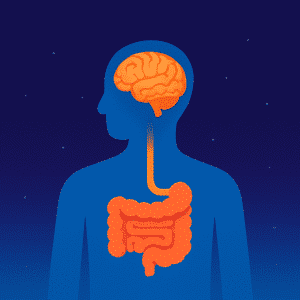
In the bustling world of health and nutrition, few organs play as quietly and unassumingly a role as the gut. While most of us only think about our intestines when we experience digestive discomfort, scientific research in recent years has shown that this complex organ is, in fact, one of the key players in our overall health.
The gut is the human body’s second brain.
This statement may sound exaggerated, but scientific evidence shows that the gut is not only responsible for digesting food but also has a direct and profound impact on mood, brain function, the immune system, and even our sleep quality.
In this article, we’ll take a detailed yet accessible look at why gut health has become a major trend in 2025, which foods help support it, and how we can transform our quality of life from the inside out with simple choices.
The Gut and the Brain: A Two-Way Relationship

It may seem strange, but the brain and the gut are in constant, uninterrupted dialogue. This connection takes place through a network called the gut–brain axis: a complex system of nerves, hormones, and chemical messengers that links the digestive tract and the brain.
🌀 Vagus Nerve: The Superhighway between the Brain and the Gut
At the heart of this connection lies the vagus nerve, which extends from the brain to the gut and carries messages in both directions. This nerve not only regulates gut motility but also informs the brain about what’s happening in the abdomen.
🌿 Does Mood Begin in the Gut?
About 90% of the body’s serotonin is produced in the gut, not in the brain. While this serotonin itself cannot cross the blood–brain barrier, gut-derived signals influence brain chemistry and mood through neural, hormonal, and immune pathways. Studies have shown that greater diversity of beneficial gut bacteria is directly associated with improved psychological well-being.
When the gut is inflamed, the brain is affected as well.
Chronic inflammation in the gastrointestinal tract can send signals to the brain that lead to feelings of fatigue, depression, or even difficulty concentrating. This is where the importance of maintaining a balanced gut microbiome becomes most apparent.
Probiotics and Prebiotics
Differences and Dietary Sources
Thus far, we’ve seen how gut health is closely linked to mood and overall bodily function. But how can we strengthen this complex, sensitive organ? The answer comes down to two words: probiotics and prebiotics. Properly understanding these two is the first step toward building a “healthy gut” in everyday life.
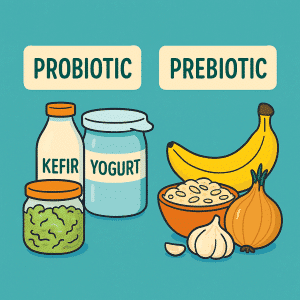
✅ What is a probiotic?
Probiotics are live, beneficial bacteria that, when introduced into the body, help strengthen the gut microbiome. These bacteria maintain the balance between good and bad microbes, reducing inflammation, improving digestion, and boosting immunity.
Natural Sources of Probiotics:
Plain unsweetened yogurt
Kefir (a type of fermented beverage)
Fermented pickles such as sauerkraut.
Kimchi ، Kombucha
✅ What is a prebiotic?
Prebiotics are non-digestible dietary fibers that serve as food for the beneficial bacteria in the gut. Without prebiotics, probiotics wouldn’t survive!
Natural sources of prebiotics:
Raw garlic and onions
Unripe bananas
Oats
Asparagus
Lentils and chickpeas
🤝 They work better together!
If you consume only probiotics without prebiotic fiber, you won’t reap much benefit. The optimal results are achieved when you incorporate both into your diet simultaneously — a combination known as synbiotic.
The Impact of Nutrition on the Gut Microbiome
In the microscopic realm of the gut, millions of beneficial and harmful bacteria are locked in a constant struggle for survival. The crucial point is that your diet plays a decisive role in tipping the balance in favor of the beneficial bacteria.
In fact, what we eat is not only fuel for our bodies but also direct nourishment for the gut microbiome.
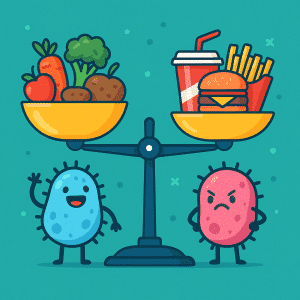
🍕 Foods that harm the microbiome:
Simple sugars (sugar, sweets, sodas):
Excellent nourishment for harmful bacteria and inflammation increase.High amounts of trans and saturated fats:
Cause a decrease in the diversity of beneficial bacteria.Ultra-processed foods (chips, fast food, sausages, and cold cuts):
Contain additives that destroy beneficial bacteria.Excessive use of antibiotics:
Even a short course can eliminate part of the beneficial gut population.
🥑 Foods that nourish the microbiome:
High-fiber vegetables: broccoli, spinach, cabbage, carrots
Legumes and whole grains: lentils, chickpeas, oats, quinoa
Fresh fruits with skin: apples, pears, unripe bananas
Natural fermented foods: kefir, yogurt, homemade pickles
Nuts and seeds: almonds, walnuts, flaxseeds, chia seeds
⚖️ Balanced nutrition = balanced microbiome
Dietary diversity is one of the most important factors for maintaining microbial diversity in the gut. The more varied and less processed foods we consume, the stronger our body’s internal ecosystem remains.
Lifestyle Factors Affecting Gut Health
Contrary to popular belief, gut health is not solely dependent on nutrition. Our daily habits—such as sleep, stress levels, and physical activity—have a profound impact on digestive function and microbiome balance.
Next, we will examine the most important lifestyle factors that can either strengthen or harm gut health:
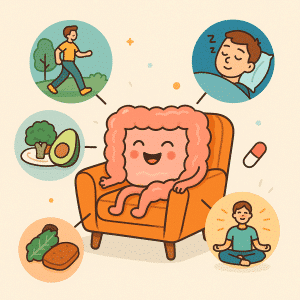
😴 Regular and Sufficient Sleep
Lack of sleep or poor-quality sleep can reduce the diversity of beneficial gut bacteria and increase inflammation levels. Getting 7–9 hours of nighttime sleep aligned with your biological clock is a key pillar of digestive health.
🧘 Reducing Chronic Stress
Psychological stress directly affects gut function and the microbiome through the vagus nerve.
Stress management through practices such as:
Meditation
Deep breathing
Yoga
Can help balance hormones and reduce digestive symptoms.
🚶♂️ Regular exercise
Research has shown that moderate aerobic exercises (such as walking, swimming, and cycling) can increase microbiome diversity and reduce gut inflammation.
Important note: Intense exercise without proper recovery may have the opposite effect!
💊 Avoiding excessive use of medications
Medications such as:
Antibiotics
Nonsteroidal anti-inflammatory drugs (NSAIDs)
Proton pump inhibitors (PPIs)
May disrupt the microbiome and lead to long-term issues such as bloating, diarrhea, or constipation.
☀️ Spending time in nature and reducing exposure to pollution
An overly sterile lifestyle, removed from natural environments, can limit the growth of a diverse microbiome. Gardening, touching soil, or even walking in nature helps the gut receive more beneficial bacteria.
New Trends in Gut Health for 2025
In 2025, gut health has moved beyond purely medical discussions to become one of the most exciting trends in lifestyle and wellness. New technologies, innovative products, and personalized approaches to nutrition have elevated gut health to a whole new level.
Next, we’ll explore this year’s hot trends:
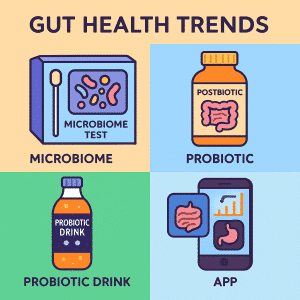
🧪 1. At-home gut microbiome tests
Advanced kits are available on the market that analyze the status of gut bacteria, microbial diversity, and gut health by simply sending a small stool sample.
Based on the results, you can receive a personalized diet plan.
📱 2. Personalized nutrition apps
With the help of artificial intelligence and data monitoring, apps have been developed that tailor your daily diet based on microbiome results, digestive symptoms, and even mood.
Examples: ZOE, DayTwo
💊 3. Next-generation supplements: “Postbiotics”
Postbiotics are metabolic products of beneficial bacteria (such as short-chain fatty acids) that are consumed in supplement form.
These supplements deliver beneficial effects without the need for live bacteria to be present.
🧉 4. Functional Drinks
Drinks such as kombucha, fiber-rich beverages, and flavored probiotic sodas have stormed the market this year.
Many of these are marketed as “Gut-Friendly” and have gained popularity among Generation Z.
🧬 5. Focus on the Gut in Healthy Aging (Longevity Science)
Research has shown that a diverse and stable microbiome is associated with longer and healthier lifespan.
In 2025, many clinics have designed programs for seniors that use the microbiome as an indicator of overall body health.
Conclusion and Practical Recommendations
The gut, this seemingly simple yet inherently complex organ, plays a role far beyond just “digesting food” in our bodies. We now understand that mental health, the immune system, sleep quality, and even our daily energy levels are all intertwined with the microscopic world inside our abdomen.
In today’s world—especially in 2025—we no longer view food merely as sustenance but consider its profound effects on our body and mind. Science tells us that with simple yet conscious choices, we can achieve a healthier gut and a more energetic life.
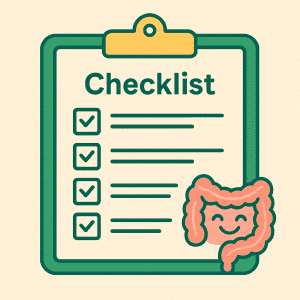
📝 Practical Checklist for Gut Health:
🔹 Consume at least one probiotic food daily (yogurt, kefir, fermented pickles)
🔹 Add natural fiber from prebiotic sources to your diet (garlic, onion, oats)
🔹 Avoid simple sugars and processed foods as much as possible
🔹 Engage in at least 30 minutes of physical activity daily
🔹 Dedicate time each day to relax your mind (meditation, deep breathing)
🔹 Take nightly sleep seriously—aim for 7–8 hours
🔹 Connect with nature; your body and gut will thank you
🔚 This article is just a starting point. Gut health is a journey built with awareness, care, and smart choices.
Maybe it’s time to improve your mind and body tomorrow with a simple change on today’s plate.
References
1. Gut-Brain Connection & Vagus Nerve
🔹 Harvard Health Publishing:
“The gut-brain connection”
https://www.health.harvard.edu/diseases-and-conditions/the-gut-brain-connection
🔹 Cleveland Clinic:
“What is the Vagus Nerve?”
https://my.clevelandclinic.org/health/body/23287-vagus-nerve
2. Probiotics & Prebiotics
🔹 National Institutes of Health (NIH):
“Probiotics: What You Need to Know”
https://www.nccih.nih.gov/health/probiotics-what-you-need-to-know
🔹 Medical News Today:
“Prebiotics vs Probiotics: Differences, Benefits, and Foods”
https://www.medicalnewstoday.com/articles/prebiotics-vs-probiotics
3. Microbiome & Diet Impact
🔹 Johns Hopkins Medicine:
“The Gut Microbiome: How It Works and Why It’s Important”
https://www.hopkinsmedicine.org/health/wellness-and-prevention/the-gut-microbiome
🔹 Healthline:
“How to Improve Gut Health Naturally”
https://www.healthline.com/nutrition/gut-health
4. Lifestyle & Gut Health
🔹 Mayo Clinic:
“Tips to Improve Gut Health Naturally”
https://www.mayoclinichealthsystem.org/hometown-health/speaking-of-health/5-tips-to-improve-gut-health
🔹 BMJ Journals – Gut:
“Stress and the gut: pathophysiology, clinical consequences, diagnostic approach and treatment options”
https://gut.bmj.com/
5. Trends in 2025
🔹 New York Post (Health):
“Top health trends to look out for in 2025”
https://nypost.com/2025/01/22/lifestyle/what-are-the-top-health-trends-to-look-out-for-in-2025/
🔹 EatingWell Magazine:
“Plant-based protein and gut health in 2025”
https://www.eatingwell.com/plant-based-protein-benefits-11712145
🔹 Real Simple:
“What is Fibermaxxing and is it good for your gut?”
https://www.realsimple.com/fibermaxxing-nutrition-trend-is-it-good-for-you-11733806
Pelank Life | Body Health Assessment
The Best Body Health Calculators Using Scientific Methods
Developed by Pelank Life ©